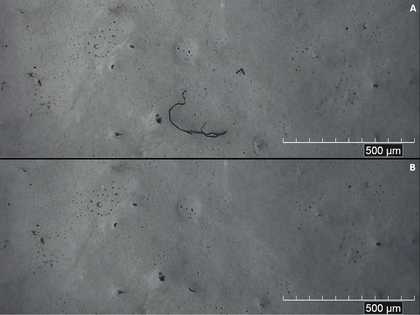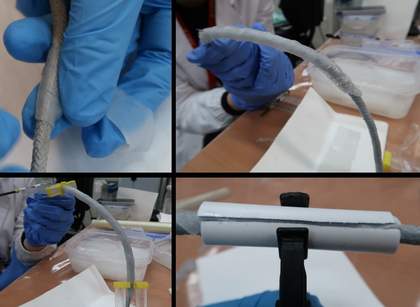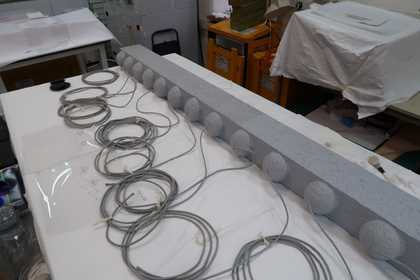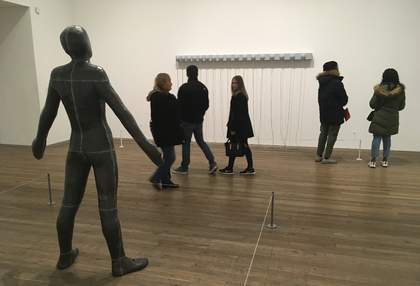In our last update, we discussed the selection process of the cleaning system, the methodology used to assess its efficacy and suitability for Addendum. We also reported on the preliminary results obtained from trials on our mock-up samples. These tests clearly showed that the two sections of the sculpture – the papier mâché and the ropes – required distinct cleaning strategies, given their different surface textures, as well as the degree and tenacity of the soiling layers.
On the papier mâché mock-ups, none of the ‘gel’ systems evaluated produced satisfactory results. Gel options with good surface contact – such as agarose, xanthan gum and Shin-Etsu KSG 350z silicone emulsifier – presented drawbacks relating to the required clearance procedures and the textures of the mock-up (and sculpture) surfaces.
The agarose gel needed to be applied warm to conform to the topography of the mock-up surfaces which would not be acceptable due to the (temperature sensitive) synthetic polymer materials used in this work. The Peggy gels showed the optimum cleaning efficacy, both when loaded with deionised water and more so when combined with the best cleaning solutions selected from our trials, i.e. an aqueous-based solution containing ECOSURF™ EH6 non-ionic surfactant and tri-ammonium citrate (TAC). However, due to the semi-rigid nature of these gels, unlike when they were used on Lichtenstein’s Whaam!, they did not conform entirely to the highly textured papier mâché surface, which resulted in an unevenly cleaned surface.

Fig.1
HIROX digital microscopic images before (top) and after (bottom) cleaning tests performed on the papier mâché section of Addendum with Boots sponge loaded in the EH6-TAC blend
Photo © Tate
Additional tests were then carried out on discrete areas on the papier mâché section of Addendum by applying the EH6-TAC blend (at different concentrations) using cosmetic sponges. These cleaning tests were performed under the HIROX microscope to examine the surfaces for undesirable swelling, abrasions and scratches. The images in fig.1, which were acquired in the same locations before and after the cleaning tests, showed that the cosmetic sponges did not cause any visible change to the surface, and hence could be safely used to clean the papier mâché section of the sculpture.
Tests carried out on the rope mock-ups demonstrated that a wide range of cleaning fluids produced some cleaning response. After evaluating the cleaning effects using microscopy and other techniques, the most promising options were discretely evaluated on the lower portion of one of Addendum’s ropes to explore how they fared on the work of art. These preliminary tests perhaps unsurprisingly revealed that the soiling layer was more heavily embedded into the ropes, than it was in our mock-ups. Hence, only a few cleaning solutions were able to pick-up enough dirt from Addendum’s ropes to warrant further exploration, the most promising being the blend of ECOSURF™ EH6 and TAC, at varied concentrations.
Among the ‘gels’ tested on the mock-up ropes, the Shin-Etsu KSG 350z emulsifier, xanthan gum, Peggy 5 and Peggy 6 options proved to be the most suitable options for cleaning, however each system had its limitations. For example, the clearance procedure required to reduce the potential for residues left on the surface can be time-consuming when using Shin-Etsu KSG 350z and xanthan gum and it is also difficult to fully remove these systems from the uneven rope surfaces.

Fig.2
Different application methods for Peggy gels on the rope mock-ups
Photo © Tate
The Peggy gels produced the best cleaning action; however, they did not make good contact with the rope surface, and when spiral-wrapped around the rope, they tended to unroll and detach. In order to achieve better surface conformity, we tried a variety of methods including cling film or clamps at the ends of the gel strip to hold the gel in position. We also tried to clamp the gel using a piece of plumbing tube cut in half and lined with Plastazote® and Melinex® (fig.2). The latter option proved to be the most effective method to guarantee continuous contact between the gel and the soiled surface, but this process meant that we could not see the rope.
We also discussed the possibility of modifying the synthesis procedure of the Peggy gels with the project lead partner (the Centre for Colloid and Surface Science – CSGI in Florence, Italy) to enhance some of the gel properties, such as adhesion to the substrate, self-adhesion and flexibility. From CSGI we received a range of different modified Peggy 5 gel options. After a series of trials, the best gel for the job was found, which we provisionally named TT14.
We then performed additional cleaning tests on discrete areas of the sculpture ropes with the best cleaning systems: xanthan gum, Shin-Etsu KSG 350z, Peggy 6 and TT14 uploaded with the best aqueous solutions, i.e. ECOSURF™EH6 and TAC at various concentrations. The tests were evaluated using microscopy and rated for a range of empirical observations (soil removal efficacy, changes in surface gloss, ease of use, ease of preparation, visible presence of residues, and user health and safety), which were summarised in a star diagram.
After extensive testing on the sculpture ropes, TT14 gel became our top-rated system. This gel offered the same cleaning efficacy of the Peggy 6 gel, but had enhanced mechanical properties and better adhesion with the substrate and with itself, which facilitated application to the ropes without the need for clamping or any other restraints. In addition, the TT14 gel did not require any mechanical action (apart from gentle massaging once it had been applied), and the clearance procedure was straightforward and less time consuming than all of the other ‘gel’ options evaluated. All these attributes made TT14 the most effective, practical and safe option for cleaning the rope portions of Addendum.
Following the same protocol used for Whaam!, before starting the full treatment of Addendum, we explored whether the TT14 gel would leave residues on the surface of the ropes after treatment. Dr David Chelazzi, from CSGI, and Tate’s NANORESTART researcher Dr Angelica Bartoletti spent a few days using an FPA-FTIR (Focal Plane Array - Fourier Transform Infrared) microscope on the rope mock-up samples after additional cleaning tests were performed with TT14 gel loaded with the EH6-TAC blend. Encouragingly, as it was the case for the Peggy 6 gel no residues were detected from either the TT14 gel or the cleaning solution.

Fig.3
Addendum during cleaning, showing half of the papier mâché section cleaned (on the bottom right), and half still to be cleaned (on the top left)
Photo © Tate

Fig.4
Addendum on display in the Natalie Bell building (Level 2 east) at Tate Modern
Photo © Tate
The treatment commenced in mid-January 2018, after receiving 70 TT14 gels. The ropes were cleaned first, and the treatment then focused on the removal of the dirt from the papier mâché section, so that the overall effect of the cleaning treatment across the entire sculpture was even. The cleaning procedure used on Addendum was optimised as follows:
- The heavily soiled ropes were cleaned using TT14 gels, loaded with a EH6-TAC blend (at a concentration of 0.75% and 2 % w/w. respectively) and left in contact with the ropes for six minutes. A clearance step was then performed using TT14 hydrogels (i.e. TT14 gels loaded with deionised water), applied using the same procedure and exposure time as with the cleaning gels. The cleaned areas were then re-assessed and treated once again if required to lift any additional soiling.
- The less-soiled papier mâché section was cleaned with an aqueous-based solution containing tri-ammonium citrate (1% w/w) and non-ionic surfactant ECOSURF™EH-6 (0.75% w/w), applied using a combination of cosmetic sponges; the clearance step was performed with adjusted water at pH 6 and conductivity 6mS/cm, in line with current recommendations for acrylic dispersion paints.
The conservation treatment was monitored and discussed at regular intervals, and the cleaning phase was completed in mid-May 2018. This was followed by minimal retouching of the upper portion, and after-treatment photography. The sculpture is now back on display, in its revived state, at Tate Modern, Natalie Bell building (Level 2 east), as part of the In the Studio display.
Angelica Bartoletti, Tamar Maor, Bronwyn Ormsby
February 2019
